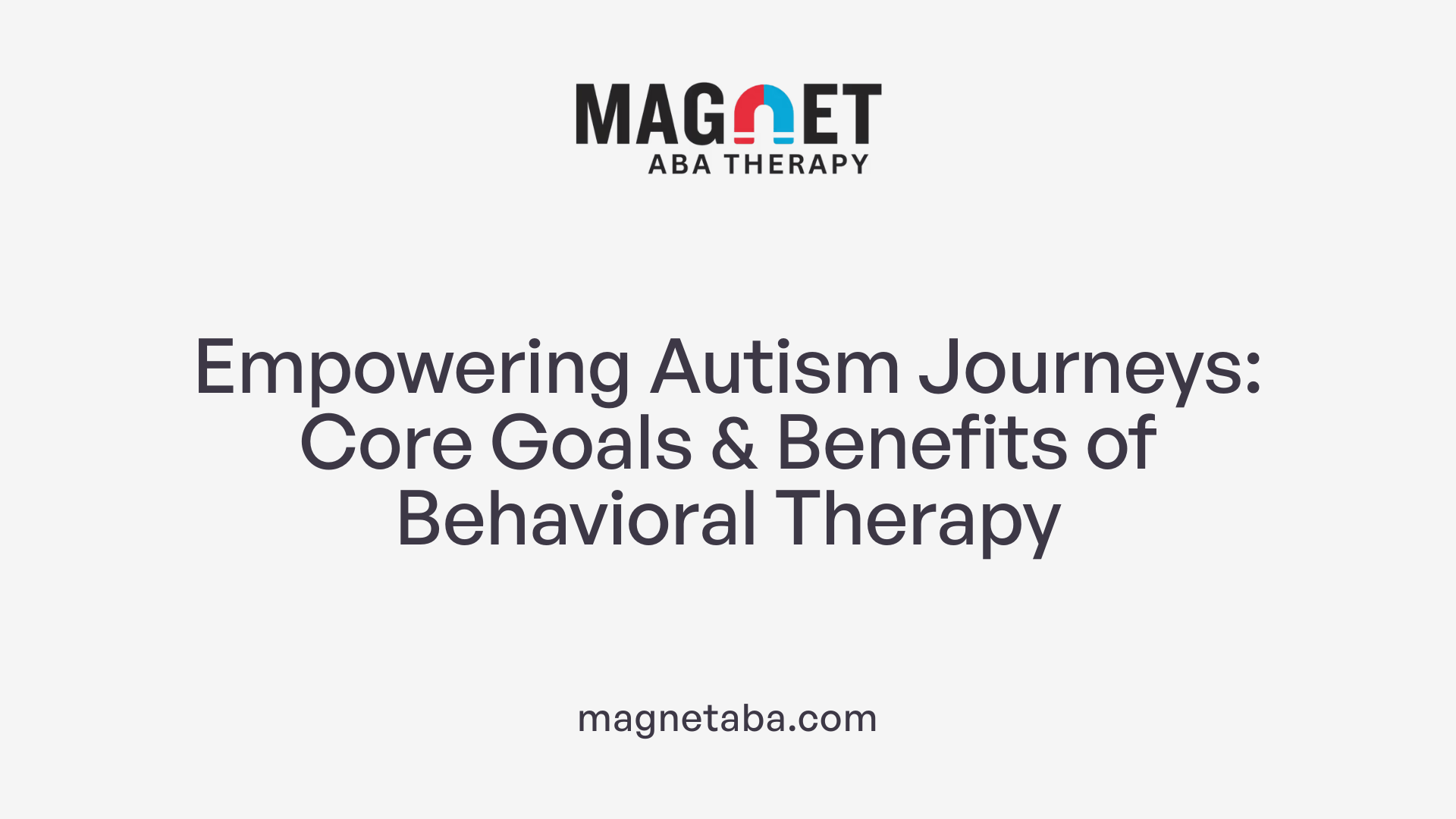Bridging Communication Gaps in Autism Spectrum Disorder
Conversational reciprocity—the natural back-and-forth rhythm of engaging dialogue—is a critical social skill that can be particularly challenging for individuals with Autism Spectrum Disorder (ASD). Teaching these skills involves more than just rote learning; it requires a nuanced approach that fosters genuine understanding and adaptive communication across different settings. Applied Behavior Analysis (ABA) therapy has emerged as a leading evidence-based intervention to support children and young adults with autism in developing effective conversational reciprocity. This article explores how ABA techniques, especially Behavioral Skills Training (BST), are employed to cultivate these essential social abilities, enhancing not only communication but also overall quality of life.
Understanding Applied Behavior Analysis (ABA) Therapy in Autism Treatment
What is Applied Behavior Analysis (ABA) therapy and how is it used in autism treatment?
Applied Behavior Analysis (ABA) therapy is a well-established, evidence-based behavioral intervention that focuses on understanding and improving human behavior using principles of learning. It is especially effective for children with autism spectrum disorder (ASD), where it helps develop essential skills such as communication, social interactions, and self-care.
Definition and Principles of ABA Therapy
ABA therapy operates on the principle that behaviors can be increased or decreased through reinforcement strategies. Positive reinforcement is commonly used to encourage desirable behaviors by providing rewarding stimuli when the behavior occurs. The therapy breaks down complex behaviors into smaller, manageable steps and teaches them using systematic approaches like discrete trial training (DTT) and natural environment teaching (NET).
Historical Background and Scientific Basis
Originating in the 1960s, ABA therapy has evolved into a scientifically validated treatment backed by decades of research. It draws from behavioral psychology to analyze and modify behaviors, leveraging data collection and behavioral assessments to guide individualized treatment plans.
Techniques Used in ABA
- Positive Reinforcement: Rewarding positive behaviors to increase their frequency.
- Behavioral Assessments: Continuous data collection to monitor progress and make adjustments.
- Individualized Plans: Tailoring interventions to each child's unique needs.
- Modeling and Role-Playing: Demonstrating skills and providing opportunities to practice.
- Visual Aids and Prompts: Supporting understanding with clear cues.
Settings for ABA Therapy Delivery
ABA interventions are versatile and can be provided in various settings including homes, schools, clinics, and community environments. This flexibility facilitates naturalistic learning experiences that help generalize skills across different contexts.
Outcomes and Research Supporting ABA Effectiveness
Extensive research supports ABA’s effectiveness in improving communication, social skills, and behavior among children with autism. Early and intensive therapy has been linked to enhanced developmental outcomes and improved quality of life. The therapy also emphasizes skill generalization, ensuring that children apply learned behaviors in real-life situations such as playdates, classrooms, and social activities.
ABA therapy, through structured support and continuous reinforcement, builds confidence and promotes meaningful social connections, making it a cornerstone treatment in autism care.
The Core Goals and Benefits of Behavioral Therapy for Autism

What are the key goals and benefits of behavioral therapy for autism?
Behavioral therapy, especially Applied Behavior Analysis (ABA), is designed to enhance communication and social skills in individuals with autism spectrum disorder (ASD). This approach breaks complex behaviors into manageable steps, teaching essential skills like initiating conversations, making eye contact, understanding social cues, and responding appropriately during interactions. By focusing on both verbal and nonverbal communication, behavioral therapy promotes effective reciprocal conversations and encourages meaningful peer interactions through cooperation, sharing, and turn-taking.
Another important goal is the reduction of interfering or challenging behaviors that may hinder learning and development. Using positive reinforcement, role-playing, and structured practice, therapy fosters independence by building daily living skills crucial for everyday functioning. Emotional regulation strategies are also emphasized, helping individuals express feelings verbally, manage conflicts calmly, and improve coping mechanisms.
Early, intensive intervention involving multidisciplinary teams and active parental participation results in significant gains. Parents play a key role by encouraging daily conversations, providing prompts, and reinforcing progress to solidify learning. Therapy’s structured yet flexible methods allow skills learned in private or clinical settings to generalize across home, school, and community environments, supporting integration and improving quality of life.
Overall, behavioral therapy provides evidence-based, personalized strategies that build confidence, social competence, and independence. It not only develops core communication and social skills but also enhances emotional well-being, leading to a more fulfilling and socially connected life for individuals with autism.
Qualified Professionals Delivering ABA Therapy

Who provides ABA therapy and what qualifications do these professionals typically have?
ABA therapy is provided by trained experts such as Board Certified Behavior Analysts (BCBAs), doctoral-level BCBA-Ds, and licensed therapists with specialized training in applied behavior analysis. To become certified, individuals typically complete an undergraduate degree related to behavioral science, followed by graduate studies in behavior analysis or a related field.
Aspiring ABA therapists must also complete supervised fieldwork hours and pass the Behavior Analyst Certification Board (BACB) examination. Those pursuing advanced credentials like BCBA or BCBA-D engage in doctoral-level education and accrue further supervised experience.
Skills and expertise required
Qualified ABA therapists bring extensive knowledge of behavioral techniques alongside strong communication and interpersonal abilities. They possess a deep understanding of autism spectrum disorder and other developmental challenges, enabling them to design individualized treatment plans effectively.
Settings where therapy is offered
These professionals deliver therapy across varied environments including private clinics, schools, healthcare facilities, and community centers. Their role involves tailoring interventions to suit each child's specific needs and promoting generalization of skills in real-world contexts.
Behavioral Skills Training (BST) and Teaching Conversational Reciprocity
What are the components of Behavioral Skills Training (BST)?
Behavioral Skills Training (BST) is a structured teaching method comprising four critical components: description, modeling, practice, and feedback. In this approach, instructors first describe the targeted social skills, providing clear explanations. Then, they model these skills by demonstrating appropriate conversational behaviors. Following this, learners practice the skills in controlled scenarios, often through role-playing or simulated interactions. Crucially, instructors offer feedback during and after practice to reinforce correct responses and guide improvements.
How is BST applied to teaching conversation skills for individuals with ASD?
BST has been effectively applied to teach multiple conversational skills in individuals with Autism Spectrum Disorder (ASD), particularly those with functional speech who attend mainstream education. The intervention focuses on enhancing reciprocal conversation skills such as beginning and ending interactions politely, shifting and following conversations, asking and answering questions, and using appropriate nonverbal cues like eye contact and gestures.
What role do simulated natural conversations play in BST?
A distinctive feature of this training is the use of simulated natural conversations that resemble real-life interactions. These scenarios include discussing preferred and nonpreferred topics, shifting between topics, and responding to varying conversational cues. By incorporating such realistic situations, learners practice adaptive conversational skills rather than relying on rote, scripted responses.
How does BST ensure skills are adaptive rather than rote?
The intervention's emphasis on varying conversational contexts helps prevent rote memorization of responses. Rehearsals involve flexible exchanges and adapting to conversational changes, encouraging learners to think actively and respond authentically. This approach enhances the generalization of skills across different people and settings.
How do rehearsal and real-time feedback support learning?
Rehearsal provides learners with repeated opportunities to practice skills in both private and natural environments. Real-time feedback during practice sessions allows immediate correction and positive reinforcement. This combination ensures that conversational skills are effectively acquired, maintained, and generalized, as shown by lasting improvements months after intervention.
Key Conversational Skills Targeted in ABA Programs
Shifting and following conversations
Individuals with ASD often struggle with maintaining the flow of conversation. ABA therapy targets skills like shifting topics smoothly and following ongoing conversations by teaching how to recognize verbal cues and respond appropriately. This aids in making interactions less scripted and more natural.
Saying thank you and using polite expressions
Politeness forms an essential part of social communication. Teaching expressions such as "thank you" reinforces positive social exchanges and helps individuals with ASD engage courteously in various situations.
Making and answering questions
Reciprocal conversation requires both asking relevant questions and answering them appropriately. ABA methods include modeling these behaviors and giving immediate feedback to encourage natural two-way communication.
Engaging in appropriate gestures and eye contact
Nonverbal communication skills like maintaining eye contact, using greetings such as handshakes, and employing suitable gestures are emphasized. Practice through role-playing and visual aids helps develop these foundational social behaviors.
Starting and ending conversations appropriately
ABA therapy also focuses on teaching how to initiate and close conversations respectfully, including how to recognize cues signifying the conversation’s end. This is crucial for smooth social interactions and is reinforced through behavioral skills training and natural environment practice.
Generalization and Maintenance of Conversational Skills
How do individuals with ASD generalize conversational skills to new social partners?
Generalization is a critical component of teaching conversational skills to individuals with ASD. Studies show that using behavioral skills training (BST) combined with in situ training and reinforcement enables learners to apply skills across novel adults and peers. By practicing in naturalistic settings, such as school or community environments, individuals effectively transfer what they've learned to real-life social interactions without showing dependence on specific people or scripted scenarios.
How is the maintenance of conversational skills measured over time?
Maintenance of skills is monitored through follow-up assessments conducted over periods ranging from 4 to 8 weeks and even several months. Data collection involves task analyses tracking steps such as maintaining eye contact, asking relevant questions, and turning conversations appropriately. Results consistently indicate that participants retain acquired social communication behaviors well beyond the immediate intervention phase.
What role does ecological validity play in teaching conversational skills?
Teaching occurs both in private, controlled settings for initial learning phases and in natural environments to foster ecological validity. Simulated natural situations—like discussing preferred and nonpreferred topics or shifting conversation topics—help ensure that skills are functional and adaptable rather than rote or scripted. This approach enhances the relevance and everyday usability of conversation skills.
How do in situ training and reinforcement support skill development?
In situ training provides opportunities for practicing conversational skills in contextual, real-world scenarios, while reinforcement encourages repetition of positive social behaviors. Feedback during rehearsal phases enables immediate adjustments and strengthens learning outcomes. This dynamic combination captures the complexity of social interactions and promotes durable behavior changes.
How is progress evaluated using a data-driven approach?
Progress is quantitatively evaluated via detailed task analyses that break down complex conversational behaviors into manageable steps. Continuous data collection allows therapists and educators to monitor mastery, identify areas needing support, and tailor interventions accordingly. This structured methodology ensures interventions are evidence-based and outcomes are measurable.
Incorporating Nonverbal Communication in ABA Therapy
Teaching eye contact, facial expressions, body language
Nonverbal communication forms a crucial part of conversation, especially for individuals with autism spectrum disorder (ASD) learning social skills through Applied Behavior Analysis (ABA) therapy. Eye contact, facial expressions, and body language are foundational elements that therapists target to improve conversational reciprocity.
Modeling and visual aids for nonverbal cues
Therapists utilize techniques such as modeling — demonstrating appropriate nonverbal behaviors — alongside visual aids and prompts, to help individuals recognize and replicate these cues. This approach helps make abstract social signals more tangible and understandable.
Importance in conversational reciprocity
Mastering nonverbal communication enhances reciprocal conversation by enabling individuals to better interpret and respond to others’ feelings and intentions, facilitating smoother, two-way social interactions.
Role of therapists in practicing these skills
Therapists create safe environments where children can practice nonverbal skills repeatedly with feedback. Practice often occurs both in private sessions and natural settings, ensuring that children generalize skills across contexts.
Enhancing social understanding through nonverbal communication
Improvement in nonverbal communication supports overall social competence by fostering better emotional regulation, cooperation, and peer engagement. ABA therapy’s structured and data-driven approach promotes steady progress in these areas, building confidence and meaningful social relationships.
Role of Real-Life Practice and Parent Involvement

Practicing Skills in Natural Settings Like School and Community
To help individuals with ASD generalize and maintain social communication skills, real-life practice in natural environments is essential. Engaging in conversations during school, community activities, or playdates allows learners to apply what they've practiced in therapy to everyday situations. This exposure to authentic social cues and varied conversational partners promotes flexible, non-rote use of skills.
Parental Encouragement and Prompting
Parents play a vital role in supporting their children's social development by encouraging daily conversations. Through gentle prompts and reminders, parents can help their children initiate interactions, ask questions, and maintain conversations. These moments create opportunities for practice outside clinical settings and foster ongoing skill development.
Recognizing and Reinforcing Progress at Home
Acknowledging a child's conversational successes at home provides positive reinforcement, which increases motivation. Praising efforts such as maintaining eye contact or appropriately ending a conversation helps children feel valued and confident in their abilities to engage socially.
Bridging Therapy and Everyday Interactions
Parents and caregivers can bridge therapy lessons with everyday life by incorporating strategies learned in ABA therapy—such as role-playing or visual prompts—into routine interactions. This continuity ensures that learned skills are not isolated to therapy sessions but become part of the child's natural communication repertoire.
Building Confidence Through Consistent Practice
Consistent practice in various settings enhances a child's confidence. As skills become more automatic through repetition and reinforcement, children with ASD feel more comfortable initiating and sustaining reciprocal conversations, which is crucial for forming meaningful social connections and improving quality of life.
Building Confidence and Social Connections Through ABA

Creating Supportive Environments in Therapy
ABA therapy provides a nurturing setting where children with autism feel safe to practice and develop social skills. Through structured sessions guided by experienced therapists, individuals receive personalized attention that encourages participation and growth.
Experiencing Success Through Small Achievements
By breaking down complex social behaviors into manageable steps, ABA helps children achieve small wins. These incremental successes build confidence, motivating them to continue improving and applying skills in various situations.
Promoting Positive Peer Interactions: Cooperation, Turn-Taking
ABA teaches essential social behaviors such as cooperation and turn-taking. Through role-playing and structured social scenarios, children learn how to initiate and maintain positive interactions with peers, fostering friendships and social acceptance.
Facilitating Emotional Regulation and Conflict Resolution
Children learn strategies like deep breathing, verbal expression of feelings, and calm conflict resolution during ABA therapy. These skills empower them to manage emotions effectively and navigate social challenges constructively.
Enhancing Meaningful Relationships
The focus on reciprocal conversation, eye contact, and appropriate social gestures supports meaningful connections. Therapy emphasizes generalizing these skills across settings like home and school, enabling children to build lasting relationships.
ABA therapy's comprehensive approach equips children with autism not only to communicate but also to thrive socially, fostering confidence and enriching their social lives.
Case Studies and Participant Diversity in Conversational Training

Inclusion of Individuals with ASD and Asperger’s Syndrome
The study included participants diagnosed with Autism Spectrum Disorder (ASD) and Asperger’s Syndrome, all of whom were enrolled in mainstream education and capable of using full sentences. This inclusion broadened the relevance of the intervention across different autism presentations.
Participants with Different Intellectual Capabilities
Three participants with varying intellectual abilities and diagnoses took part, showcasing the training’s adaptability to individual needs and cognitive levels within the autism spectrum.
Adaptability of Interventions Across Diagnosis
By incorporating behavioral skills training (BST) methods such as instruction, modeling, rehearsal, and feedback, the intervention demonstrated flexibility in addressing the unique conversational challenges faced by each participant, regardless of their specific diagnosis.
Use of Task Analysis to Track Progress
A detailed task analysis was developed, measuring both vocal and non-vocal conversational steps like maintaining eye contact, asking relevant questions, and appropriately ending conversations. This tool enabled precise monitoring of skill acquisition and progression.
Assessment of Social Validity and Satisfaction
Post-intervention assessments revealed that the conversational skills were maintained over months and generalized to interactions with novel peers and adults. Moreover, high satisfaction scores from parents and participants highlighted the social validity and acceptability of the teaching procedures and outcomes.
The Lasting Impact of ABA on Conversational Reciprocity
Applied Behavior Analysis therapy offers a structured, evidence-based framework for teaching conversational reciprocity to individuals with autism spectrum disorder. Through targeted interventions such as Behavioral Skills Training, therapists can effectively foster complex social communication skills, including verbal and nonverbal exchanges, that are maintained and generalized across diverse settings and interactions. Supported by skilled professionals and active parental involvement, ABA empowers learners to build meaningful relationships, manage social nuances, and boost their confidence. As research advances and individualized approaches evolve, ABA continues to be a cornerstone in unlocking the potential for reciprocal conversation and social integration in the autism community.
References
- Toward Meaningful Outcomes in Teaching Conversation ...
- Using a behavioral skills training package to teach ...
- Teaching Reciprocal Conversation for Autism
- How ABA Therapy Helps Improve Social Skills in Children
- Behavioral Therapy for Autism Spectrum Disorder in ...
- Behavioral Management Therapy for Autism | NICHD
- 6 Benefits of ABA Therapy for Children with Autism
- Behavioral Therapy for Children with Autism












